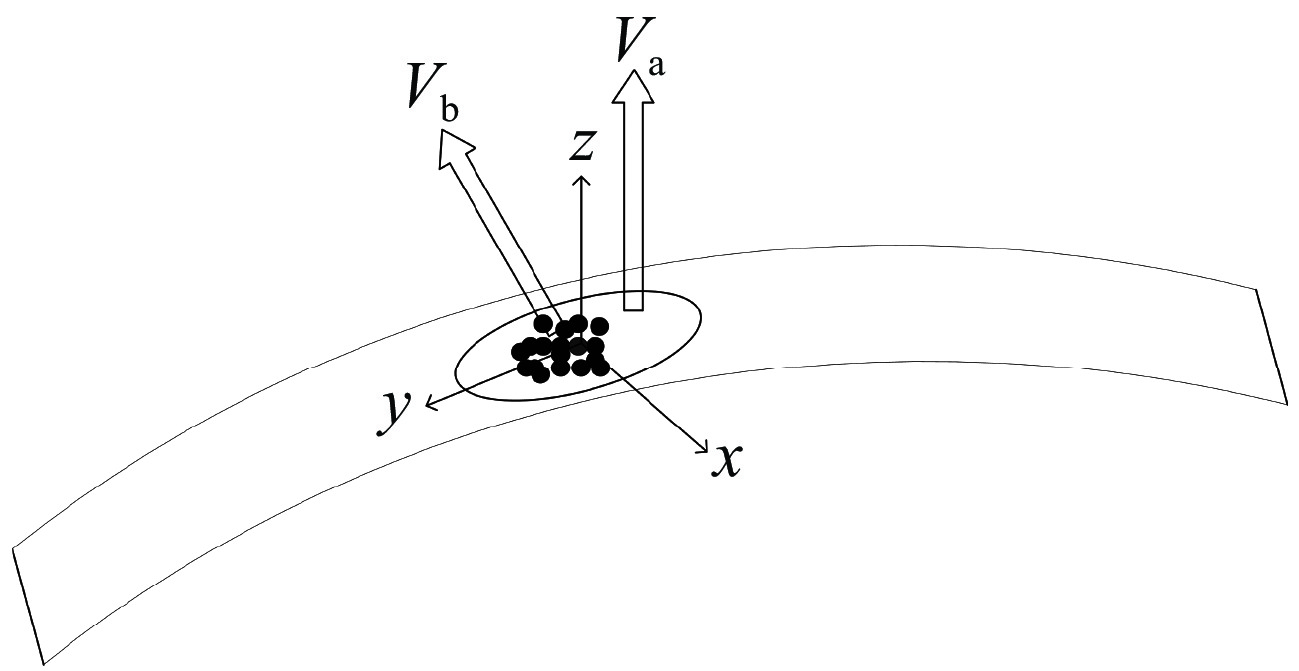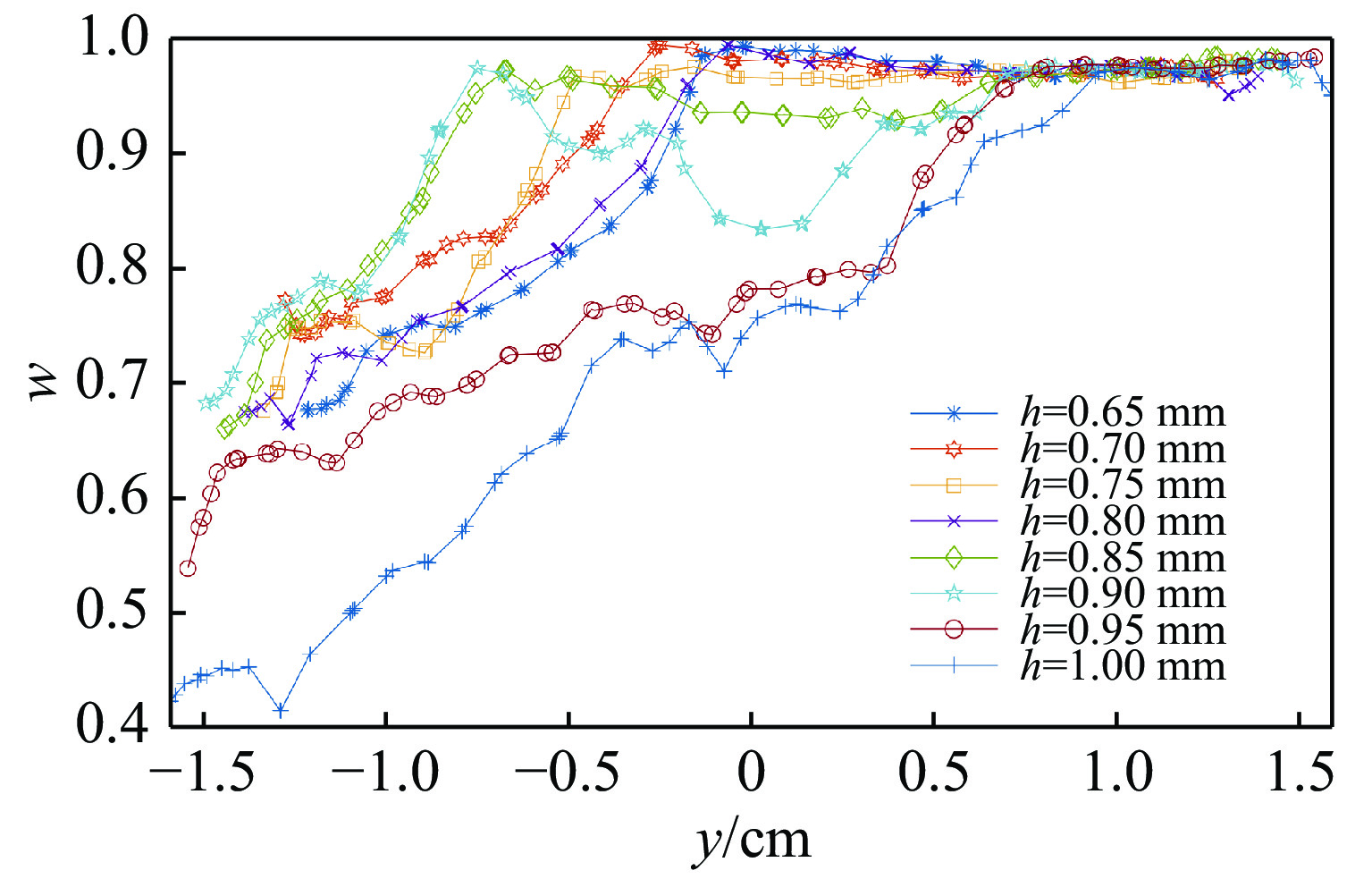Fast calculation of polishing powder sedimentation characteristics in magnetorheological polishing area under gradient magnetic field based on Kahan linearization
-
摘要: 针对抛光粉沉降特性数值计算这一超大规模非线性问题,基于Kahan线性化解决了超大规模流固耦合计算问题。研究了以羟基铁粉和硅油为主要成分组合而成的抛光粉多相流在梯度磁场下抛光区域的沉降特性。以质量分数70%、粒径5 µm的羟基铁粉和粘度为0.973 Pa·s的硅油组合而成的抛光粉为研究对象,实现了不同的抛光轮转速、不同嵌入深度以及不同羰基铁粉质量分数情况下的沉降规律分析。结果发现:磁流变抛光区域的抛光粉会随着抛光轮转速的增大而增多;当到达出口时,抛光粉的分布趋于稳定状态;抛光粉会随着嵌入深度的增加而增多并存在饱和区;羟基铁粉的质量分数以非线性的方式影响沉降能力。Abstract: The sedimentation characteristics of the magnetic polishing liquid in the magnetorheological polishing area is an important part of the material removal mechanism in the polishing process. Aiming at the ultra-large-scale nonlinear problem of numerical calculation of polishing powder sedimentation characteristics, this paper solves the ultra-large-scale fluid-structure interaction calculation problem based on Kahan linearization. The sedimentation characteristics of the multiphase flow of polishing powder composed of hydroxy iron powder and silicone oil in the polishing area under gradient magnetic field were studied. Taking the polishing powder composed of hydroxyl iron powder with mass fraction of 70% and particle size of 5um and silicone oil with viscosity of 0.973 Pa·s as the research object, sedimentation analysis of different polishing wheel rotation speeds, different embedding depths and different mass fractions of carbonyl iron powder were realized. It is found that the polishing powder in the magnetorheological polishing area will increase with the increase of the rotating speed of the polishing wheel; when it reaches the outlet, the distribution of the polishing powder tends to be stable; the polishing powder will increase with the increase of the embedded depth and there is a saturation zone; the mass fraction of hydroxy iron powder affects the sedimentation ability in a non-linear manner.
-
表 1 实验物理参数
Table 1. Experimental physical parameters
particle
diameter/μmair-silicon
soil tensor/Nsilicone oil
viscosity/Pa·ssilicone oil
density/(kg·m−3)import and export
pressure/Paradius of curvature of the
polishing wheel/mm5 0.04 0.973 0.94 101325 150 表 2 抛光轮不同转速参数
Table 2. Different speed parameters of polishing wheel
mass fraction/% embedded depth /mm polishing rotation /r/min 70 1.1 100 70 1.1 125 70 1.1 150 70 1.1 175 70 1.1 200 70 1.1 225 70 1.1 250 70 1.1 275 表 3 不同嵌入深度参数
Table 3. Different embedding depth parameters
mass fraction/% polishing rotation/(r·min−1) embedded depth h/mm 70 150 0.65 70 150 0.70 70 150 0.75 70 150 0.80 70 150 0.85 70 150 0.90 70 150 0.95 70 150 1.00 表 4 改变抛光粉中羟基铁粉的质量分数
Table 4. Changing the mass fraction of hydroxyl iron powder in polishing powder
silicone oil
viscosity/(mPa·s)hydroxy liron
powder/μmmass fraction
w0/%97.3 5 20 97.3 5 30 97.3 5 40 97.3 5 50 97.3 5 60 97.3 5 70 97.3 5 80 97.3 5 90 -
[1] 康桂文. 磁流变抛光技术的研究现状及其发展[J]. 机床与液压, 2008, 36(3):173-175,182. (Kang Guiwen. Research and development of magnetorheological finishing[J]. Machine Tool & Hydraulics, 2008, 36(3): 173-175,182 doi: 10.3969/j.issn.1001-3881.2008.03.058Kang Guiwen. Research and development of magnetorheological finishing[J]. Machine Tool & Hydraulics, 2008, 36(3): 173-175, 182 doi: 10.3969/j.issn.1001-3881.2008.03.058 [2] 王嘉琪, 肖强. 磁流变抛光技术的研究进展[J]. 表面技术, 2019, 48(10):317-328. (Wang Jiaqi, Xiao Qiang. Research progress of magnetorheological polishing technology[J]. Surface Technology, 2019, 48(10): 317-328Wang Jiaqi, Xiao Qiang. Research progress of magnetorheological polishing technology[J]. Surface Technology, 2019, 48(10): 317-328 [3] 张峰, 余景池, 张学军, 等. 对磁流变抛光技术中磁场的分析[J]. 仪器仪表学报, 2001, 22(1):42-44,48. (Zhang Feng, Yu Jingchi, Zhang Xuejun, et al. Analysis of magnetic field used in magnetorheological finishing[J]. Chinese Journal of Scientific Instrument, 2001, 22(1): 42-44,48 doi: 10.3321/j.issn:0254-3087.2001.01.012Zhang Feng, Yu Jingchi, Zhang Xuejun, et al. Analysis of magnetic field used in magnetorheological finishing[J]. Chinese Journal of Scientific Instrument, 2001, 22(1): 42-44, 48 doi: 10.3321/j.issn:0254-3087.2001.01.012 [4] 路家斌, 宾水明, 阎秋生, 等. 磁场分布对多磨头磁流变抛光材料去除的影响[J]. 润滑与密封, 2020, 45(4):20-26. (Lu Jiabin, Bin Shuiming, Yan Qiusheng, et al. Effect of magnetic field distribution on material removal in magnetorheological finishing with multiple polishing heads[J]. Lubrication Engineering, 2020, 45(4): 20-26 doi: 10.3969/j.issn.0254-0150.2020.04.004Lu Jiabin, Bin Shuiming, Yan Qiusheng, et al. Effect of magnetic field distribution on material removal in magnetorheological finishing with multiple polishing heads[J]. Lubrication Engineering, 2020, 45(4): 20-26 doi: 10.3969/j.issn.0254-0150.2020.04.004 [5] 姜涛. 高效气囊抛光中频误差控制路径规划[J]. 广东化工, 2020, 47(19):58-60. (Jiang Tao. Path planning of mid-spatial frequency control in high efficiency bonnet polishing[J]. Guangdong Chemical Industry, 2020, 47(19): 58-60 doi: 10.3969/j.issn.1007-1865.2020.19.024Jiang Tao. Path planning of mid-spatial frequency control in high efficiency bonnet polishing[J]. Guangdong Chemical Industry, 2020, 47(19): 58-60 doi: 10.3969/j.issn.1007-1865.2020.19.024 [6] 顾勇兵, 张云, 王于岳, 等. 磁流变抛光液沉降稳定性的研究[J]. 金刚石与磨料磨具工程, 2013, 33(5):27-30,34. (Gu Yongbing, Zhang Yun, Wang Yuyue, et al. Study on the sedimentation stability of magnetorheological fluid[J]. Diamond & Abrasives Engineering, 2013, 33(5): 27-30,34Gu Yongbing, Zhang Yun, Wang Yuyue, et al. Study on the sedimentation stability of magnetorheological fluid[J]. Diamond & Abrasives Engineering, 2013, 33(5): 27-30, 34 [7] 王弘义, 罗一平, 纪东升, 等. 基于动力学模拟的磁流变液沉降模拟方法[J]. 农业装备与车辆工程, 2020, 58(12):51-55. (Wang Hongyi, Luo Yiping, Ji Dongsheng, et al. Simulation method of MR fluid settlement based on dynamic simulation[J]. Agricultural Equipment & Vehicle Engineering, 2020, 58(12): 51-55 doi: 10.3969/j.issn.1673-3142.2020.12.012Wang Hongyi, Luo Yiping, Ji Dongsheng, et al. Simulation method of MR fluid settlement based on dynamic simulation[J]. Agricultural Equipment & Vehicle Engineering, 2020, 58(12): 51-55 doi: 10.3969/j.issn.1673-3142.2020.12.012 [8] 尹韶辉, 邓子默, 郭源帆, 等. 单晶碳化硅的电磁场励磁大抛光模磁流变抛光[J]. 表面技术, 2020, 49(10):309-315. (Yin Shaohui, Deng Zimo, Guo Yuanfan, et al. Magnetorheological polishing using large polishing tool excited by electromagnetic field for silicon carbide wafer[J]. Surface Technology, 2020, 49(10): 309-315Yin Shaohui, Deng Zimo, Guo Yuanfan, et al. Magnetorheological polishing using large polishing tool excited by electromagnetic field for silicon carbide wafer[J]. Surface Technology, 2020, 49(10): 309-315 [9] 金宝炎, 包小倩, 张茂才, 等. 表面改性对磁流变液稳定性和磁流变性能的影响[J]. 磁性材料及器件, 2007, 38(4):51-54. (Jin Baoyan, Bao Xiaoqian, Zhang Maocai, et al. Effect of surface modification on the stability and magnetorheology of magnetorheological fluids[J]. Journal of Magnetic Materials and Devices, 2007, 38(4): 51-54 doi: 10.3969/j.issn.1001-3830.2007.04.014Jin Baoyan, Bao Xiaoqian, Zhang Maocai, et al. Effect of surface modification on the stability and magnetorheology of magnetorheological fluids[J]. Journal of Magnetic Materials and Devices, 2007, 38(4): 51-54 doi: 10.3969/j.issn.1001-3830.2007.04.014 [10] 唐欣, 凌虹, 胡克鳌. 磁流变液沉降稳定性研究现状与趋势[J]. 磁性材料及器件, 2004, 35(3):5-8. (Tang Xin, Ling Hong, Hu Keao. Current status and future trends of research in subsidence stability of magnetorheological fluids[J]. Journal of Magnetic Materials and Devices, 2004, 35(3): 5-8 doi: 10.3969/j.issn.1001-3830.2004.03.002Tang Xin, Ling Hong, Hu Keao. Current status and future trends of research in subsidence stability of magnetorheological fluids[J]. Journal of Magnetic Materials and Devices, 2004, 35(3): 5-8 doi: 10.3969/j.issn.1001-3830.2004.03.002 [11] 胡林, 付伟, 张朝平, 等. 磁流变液沉降稳定性改进及对流变性能的影响[J]. 贵州大学学报(自然科学版), 2001, 18(3):176-181. (Hu Lin, Fu Wei, Zhang Chaoping, et al. Modification of the subsidence stability in magnetorheological fluids and influence of profiles on rheological[J]. Journal of Guizhou University (Natural Science), 2001, 18(3): 176-181Hu Lin, Fu Wei, Zhang Chaoping, et al. Modification of the subsidence stability in magnetorheological fluids and influence of profiles on rheological[J]. Journal of Guizhou University (Natural Science), 2001, 18(3): 176-181 [12] 白杨, 张峰, 邓伟杰, 等. 磁流变抛光液的配制及其抛光稳定性[J]. 光学学报, 2014, 34:0416001. (Bai Yang, Zhang Feng, Deng Weijie, et al. Preparation of magnetorheological polishing fluid and its polishing stability[J]. Acta Optica Sinica, 2014, 34: 0416001 doi: 10.3788/AOS201434.0416001Bai Yang, Zhang Feng, Deng Weijie, et al. Preparation of magnetorheological polishing fluid and its polishing stability[J]. Acta Optica Sinica, 2014, 34: 0416001 doi: 10.3788/AOS201434.0416001 [13] Kumar M, Singh Yadav H N, Kumar A, et al. An overview of magnetorheological polishing fluid applied in nano-finishing of components[J]. Journal of Micromanufacturing, 2021, 2021: 25165984211008173. [14] Ghosh G, Sidpara A, Bandyopadhyay P P. Experimental and theoretical investigation into surface roughness and residual stress in magnetorheological finishing of OFHC copper[J]. Journal of Materials Processing Technology, 2021, 288: 116899. doi: 10.1016/j.jmatprotec.2020.116899 [15] Arora K, Singh A K. Theoretical and experimental investigation on surface roughness of straight bevel gears using a novel magnetorheological finishing process[J]. Wear, 2021, 476: 203693. doi: 10.1016/j.wear.2021.203693 [16] Gopinath B, Sathishkumar G K, Karthik P, et al. A systematic study of the impact of additives on structural and mechanical properties of magnetorheological fluids[J]. Materials Today: Proceedings, 2021, 37: 1721-1728. doi: 10.1016/j.matpr.2020.07.246 [17] Lu Qi, Choi K, Nam J D, et al. Magnetic polymer composite particles: design and magnetorheology[J]. Polymers, 2021, 13: 512. doi: 10.3390/polym13040512 [18] Shen Jianyun, Qian Feng, Wu Xian, et al. Fundamental study on CNC polishing method with inner channel liquid supply[J]. The International Journal of Advanced Manufacturing Technology, 2021, 114(3): 1075-1085. -





 下载:
下载:







